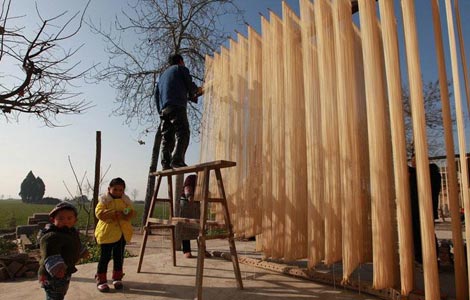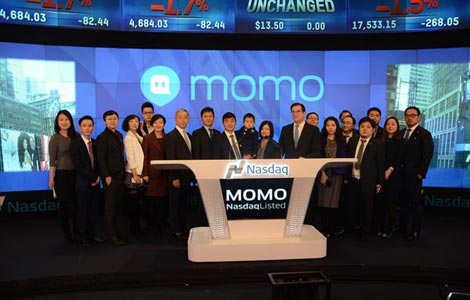China, US to tap trade, investment potential
Updated: 2014-12-12 06:54
By CHEN WEIHUA in Washington(China Daily USA)
|
||||||||
Just a month after US President Barack Obama visited Beijing, senior Chinese and US officials will meet next week in Chicago for a high-level forum to address bilateral trade and investment issues and promote business opportunities.
The Chinese delegation to the 25th session of the China-US Joint Commission on Commerce and Trade (JCCT) from Dec 16-18 will be led by Vice Premier Wang Yang and the US side by Secretary of Commerce Penny Pritzker and US Trade Representative Michael Froman.
It will be the first time for the JCCT to include a full day of events designed to facilitate private sector engagement with officials from Chinese and US governments, according to the US Department of Commerce.
This year's JCCT will also include a roundtable discussion on bilateral investment, a cooperative travel and tourism program and developing a shared vision of economic leadership.
Fast-growing trade and investment ties have long been regarded as an important anchor for a stable bilateral relationship between the two nations.
Speaking to the President's Export Council on Thursday, Obama said China has a great interest in the relationship with the US and recognizes the interdependence that has evolved between the two economies.
"The business investment treaty that they have shown an interest in negotiating could end up being a significant piece of business. We actually saw some movement during my last trip on issues surrounding technology," Obama told the council, comprised of private business leaders, lawmakers, governors and mayors and his cabinet members.
During Obama's trip to Beijing last month, the two governments reached a landmark deal on climate change with commitment on reducing carbon emissions. They also agreed to reciprocally issue 10-year business and tourist visas and five-year student visas, to expand the scope of the Information Technology Agreement (ITA) and speed up negotiations of the Bilateral Investment Treaty (BIT), which have been widely applauded by the business communities in both countries.
In Beijing on Thursday, representatives from the two countries kicked off a five-day 17th round of the BIT talks.
"It was agreed that the two sides will make best efforts to reach agreement by the end of the year on core issues and major clauses of the treaty and launch negative list negotiations next year," Zhang Yesui, China's executive vice-foreign minister, told the annual conference of China US Exchange Foundation in Hong Kong last week.
"We hope to see a mutually beneficial, win-win and high-standard treaty," said Zhang, a former Chinese ambassador to the US.
Sean Minder, the China program manager and research associate at the Washington-based Peterson Institute for International Economics, said a BIT would increase foreign direct investment between China and the US.
"The economic benefits from increased FDI would flow both ways and encourage needed structural reforms in both countries," Miner wrote in an article published on the Peterson Institute website.
On Tuesday, Commerce Secretary Pritzker hailed the reciprocal visa agreement between China and the US. She highlighted the 1.8 million Chinese visitors who traveled to the US last year, spent $21 billion and supported more than 100,000 American jobs.
"With this change in our visa policy, up to 7.3 million Chinese visitors will travel to the US by 2021, contributing nearly $85 billion per year to our economy and supporting as many as 440,000 jobs, four times the economic and job impact of today," Pritzker told the White House Travel Bloggers Summit on Tuesday.
Pritzker and US Secretary of Energy Ernest Moniz announced on Monday that they will lead a business-development mission to China next April to focus on industries that support smart cities and smart growth, an effort to help strengthen and expand US-China clean-energy cooperation following the recent climate deal.
The US is China's largest trading partner and China is the second-largest trade partner for the US, trailing Canada.
According to a US-China Business Council report, US exports to China have grown faster than exports to any other major US trading partner. The 255 percent growth from 2004 to 2013 means an average annual growth of 15.1 percent.
In 2013, US exports to China helped support a wide range of industries, such as transportation equipment, crop production, computers and electronics and chemicals, along with export-related jobs in America's port cities, according to the report.
China was among the top three export markets for 42 US states in 2013. More US governors are leading trade missions to China these days. Just late last month, Michigan Governor Rick Snyder, who was re-elected earlier in the month, led his fourth trade mission to China, going to several Chinese cities.
Amid booming bilateral trade and investment, the two countries have also struggled to sort out differences and disputes. In addressing his Export Council on Thursday, Obama noted that the US will continue to press China on areas where trade is imbalanced. He cited currency practices, the protection of intellectual property rights and state-owned enterprises.
US Undersecretary of Treasury Nathan Sheets said last week that China has made improvements over the years in a market-determined exchange rate and the protection of intellectual property rights, but he said more needs to be done.
China has urged the US to further lift its ban on high-tech exports to China and treat Chinese investors in a fair way.
chenweihua@chinadailyusa.com
Most Viewed
Editor's Picks

|

|

|

|

|

|
Today's Top News
Lima sets groundwork for Paris talks
China, Kazakhstan to sign $10b deals during Li's visit
HK police to clear last occupy site Monday
Nanjing memorial gains global media attention
UN climate change summit faces deadlock
Xi attends China's first memorial ceremony
Three pilot trade zones proposed
US big-data company expands into China
US Weekly

|

|















